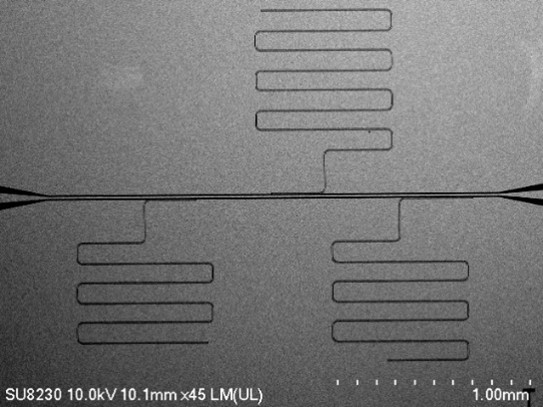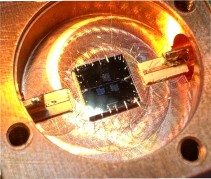Pushing the boundaries of quantum: development of high-Q tantalum superconducting circuits on silicon chip
Published: 8 October 2025
Shima Poorgholam-Khanjari, Valentino Seferai, Paniz Foshat, Calum Rose, Hua Feng, Robert H. Hadfield, Martin Weides, and Kaveh Delfanazari explore high-performance superconducting circuits made of tantalum.
Tantalum is one of the most promising materials for superconducting quantum devices, which offers low microwave loss. Its excellent compatibility with CMOS fabrication also makes it a strong candidate for scalable quantum computing. In this project [1], we utilised the advanced capabilities of the James Watt Nanofabrication Centre (JWNC) of the University of Glasgow to design high-performance superconducting circuits made of tantalum. The core of our project is the precise manufacture of high-quality-factor superconducting tantalum microwave resonators.
To fabricate these circuits, we used a wide range of JWNC’s world-class tools:
- A Plassys deposition tool for reactive magnetron sputtering of superconducting metals and their nitrides.
- An EBPG 5200 for e-beam lithography of nanometer-scale circuits.
- A Plasmalab system 100 from Oxford Instruments for the selective and precise etching of our devices at the last stage.
Finally, after all of the fabrication steps, the superconducting tantalum chip was measured at cryogenic temperatures in a dilution refrigerator and showed that the resonators performed exceptionally well, demonstrating the outstanding quality of fabrication possible at JWNC.
This project has the potential to significantly showcase the JWNC's role as a leader in quantum technology by providing access to advanced tools and supporting researchers through every step of development. Pushing the boundaries of superconducting circuit fabrication will help the JWNC and University of Glasgow maintain their position at the forefront of technological advancement. Additionally, by allowing researchers to engage with a range of equipment and explore state-of-the-art nanofabrication techniques, this project offers exceptional learning opportunities.


Fig. 13 a (cover image) SEM image of Ta CPW resonators
Fig. 13 B (above) wirebonded chip to a copper packaged box
[1] Shima Poorgholam-Khanjari, Valentino Seferai, Paniz Foshat, Calum Rose, Hua Feng, Robert H. Hadfield, Martin Weides & Kaveh Delfanazari, Engineering high-Q superconducting tantalum microwave coplanar waveguide resonators for compact coherent quantum circuit, Scientific Reports 15, 27113 (2025) https://www.nature.com/articles/s41598-025-11744-x
First published: 8 October 2025

